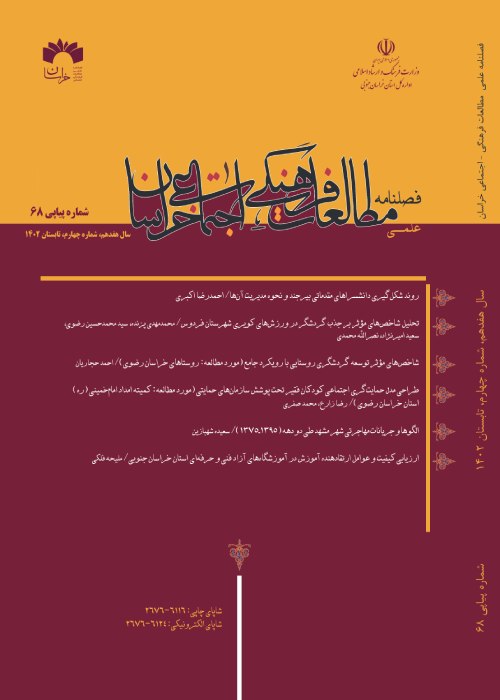Effective Indicators of Rural Tourism Development: A Comprehensive Approach (A Case Study of Villages in Khorasan Razavi)
Rural tourism is a topic of considerable debate within the tourism industry, primarily due to its objectives. These include empowering local communities, fostering social and economic development, preserving natural and cultural resources, and providing high-quality visitor experiences. This is achieved through the integration of all stakeholders in the planning and development process of tourism, with the aim of creating resources for the local community. Such initiatives have garnered support from various international organizations, including the World Bank (2013). Rural tourism not only helps protect local communities from the pervasive influence of globalization, but also contributes to the well-being of local residents. This is achieved through the development of infrastructure (such as transportation networks, water, electricity, communications, and superstructures), legal and institutional structures, health, safety, security, civil rights, and the conservation of the environment, heritage, and culture. These developments cater not only to the needs of tourists but also ensure the preservation of localities (Goodwin & Santilli, 2009). Furthermore, rural tourism provides, expands, and improves livelihood resources and opportunities to earn income. These earnings are often used for essential life necessities, such as education, medical care, clothing, and housing. The province of Razavi Khorasan, located in the northeastern part of the country, receives a significant number of religious tourists. Given the large number of rural areas in this province that are suitable for tourism and ecotourism, it can be considered a dominant spatial model of rural tourism. This research seeks to answer the question: What are the indicators that influence the state of rural tourism in Razavi Khorasan Province?
The current research is applied in terms of its purpose and causal in terms of its nature. The statistical population of this study includes the villages that had the most tourist destinations in 2023. As such, 19 villages have been selected based on this criterion. Next, the total number of households in the sample population (N = 3808 households) was considered, and using Cochran’s formula (with an error of 0.05%), a sample size of 339 households was obtained. The number of households in each village was determined first, and then the number of samples was distributed among each of the sample villages according to the number of their households. For this purpose, initially, 10 questionnaires were distributed in equal proportions for each village as a basis, and the rest of the sample size was distributed among the sample villages according to the number of households in the village. The selection of samples was done using a systematic random method. The face and content validity of the questionnaire was confirmed by the corrective opinion of university professors and experts, and necessary corrections were made in several stages. The Cronbach’s alpha method was used in SPSS 22 to comply with the work principles and technique and to measure the level of reliability in the formulation and setting of the questionnaire. The Structural Equation Model through Smart PLS has been used to measure the collected data.
This study aims to investigate the impact of tourism development indicators on rural tourism from the perspective of villagers, using a structural equation modeling approach. The case study was conducted on the target villages of Razavi Khorasan province. The development of rural tourism was evaluated using four components as scales: socio-cultural, economic, planning-management, and infrastructural-service indicators. To test the conceptual model of the research and examine the impact of these dimensions on rural tourism, a partial least squares (PLS) technique was used. This was done after confirming the positive and significant correlation of these variables with Pearson’s correlation test. The results obtained from the Smart PLS software confirmed the external test of the model (divergent and convergent validity values, Cronbach’s alpha, and composite reliability). It showed that the t coefficients between the main constructs of the research were above 2.58, indicating a significant and direct relationship between the variables. The economic dimension, considering both direct and indirect effects, had a greater impact on the development of rural tourism with a coefficient of 0.89. Planning and management indicators also had a relatively large impact on the development of rural tourism in the study area, with an impact factor of 0.449. Infrastructure and service indicators were in the third stage with a factor of 0.197. It should be noted that socio-cultural indicators had the least impact on the development of rural tourism in the studied area. In general, the value of R2 for the change variable of rural tourism development was 0.843. This suggests that the achievement of social, economic, planning, and managerial indicators, as well as infrastructure and services, had a significant impact on the development of rural tourism in the study area. In fact, 94.3% of the changes in tourism development in the study area are predicted by these four indicators. The value obtained for the GOF index (0.861) also confirms the excellent fit of the structural model of the research.
- حق عضویت دریافتی صرف حمایت از نشریات عضو و نگهداری، تکمیل و توسعه مگیران میشود.
- پرداخت حق اشتراک و دانلود مقالات اجازه بازنشر آن در سایر رسانههای چاپی و دیجیتال را به کاربر نمیدهد.



